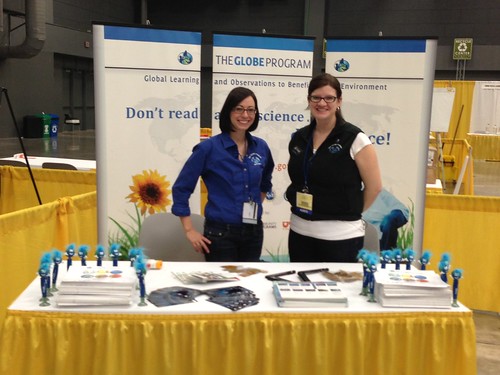.png)
This week I attended the 93rd Annual Meeting of the American Meteorological Society (AMS) in Austin, TX. I started attending eight years ago as a senior undergraduate meteorology major at Millersville University. That first year, I’ll admit, was very overwhelming – great minds from various expertises within the Earth Sciences came together to share ideas and present their recent research. The meeting brings many opportunities for sharing: from WeatherFest, a collection of over 65 interactive science exhibits that is free to the community, to posters and formal presentations at the meeting venue.
Like the past few years, GLOBE sponsored a table at WeatherFest, where we met members of the Austin community – from local scout troops to teachers and students. We explored with them how fun and easy GLOBE is, by engaging with Green Down and Surface Temperature focused activities. We also shared calendars from the student art competition. Everyone who stopped by the table loved how you, our GLOBE Students, represented climate through your art. WeatherFest occurs the Sunday prior to each AMS meeting, and next year’s will be in Atlanta, GA, USA. Check out this link to watch a video of images from this year’s WeatherFest, courtesy of Teresa Eastburn of UCAR’s SPARK Program.

Julie and I take a moment to take a picture before the doors to WeatherFest open
The Meeting officially kicked off on Monday, and I was able to present how GLOBE connects to the Next Generation Science Standards, which was timely as a new draft of the standards was released on Tuesday. GLOBE itself connects so well to the Next Generation Science Standards , as student research projects touch on each of the three dimensions of the new standards. The three dimensions, to be explained briefly, are Scientific and Engineering Practices, Crosscutting concepts, and Disciplinary Core Ideas. As you’re aware, one of the key components of GLOBE is its inquiry-based, hands-on activities. This aligns to Dimension 1 of the Standards. To address the different cross-cutting concepts, Dimension 2 of The Standards, GLOBE Students and Teachers engage in data analysis and application to research projects. Finally, basic GLOBE, the implementation of GLOBE protocols aligns to Dimension 3 – disciplinary core ideas. By looking at even one project, such as the Oyster Gardening and Climate Change project from Trinity Lutheran School in Newport News, VA, USA, it is easy to make the connection. Once the standards are finalized, we’ll be sure to feature a post or two dedicated to how GLOBE connects to them.
On Tuesday, GLOBE was presented again to the AMS audience by showing how GLOBE students are environmental stewards in their local communities. Since the presentation was only limited to 12 minutes, I was only able to discuss two projects: one from students in the Czech Republic who were looking out for toads crossing a busy highway, and another from students in Pakistan who created fliers to pass out to the community in hopes to clean up and protect their local water source. Everyone in attendance was impressed when they realized that students recognize problems, research these problems using GLOBE protocols and work to find a solution. Also on Tuesday, one of our GLOBE Teachers, Mr. Peter Dorofy from the Burlington County Institute of Technology in New Jersey, received the American Meteorological Society’s K-12 Educator Award. He attended the meeting too, and will be blogging about his experience at the science conference in the near future.
As the week came to a close, we feel confident that The GLOBE Program had been shared in many ways with this wide scientific audience. I was able to meet scientists and educators who are able to bring amazing expertise to students and teachers alike. I have been able to reconnect with GLOBE partners, who are attending the meeting as representatives of their organization, as well as network with the local Austin community in hopes to recruit new GLOBE teachers and schools. It is our hope that in future meetings, we can continue to present what you, our GLOBE Community, are doing. Whether it be future results of another competition or presenting the latest way our students are environmental stewards, members of the American Meteorological Society are inspired by what you are doing.
Suggested activity: Students – Get together with your classmates and look around your community to find a local problem and develop a project to answer the question. Then, submit it to us through the GLOBE Facebook Page or have your teacher submit it through the “Tell Us About It” link on their My Page on the GLOBE Website.Teachers – read through the latest draft of the Next Generation Science Standards and provide your feedback. The draft will be open for comments until 29 January 2013.
-Jessica Mackaro
